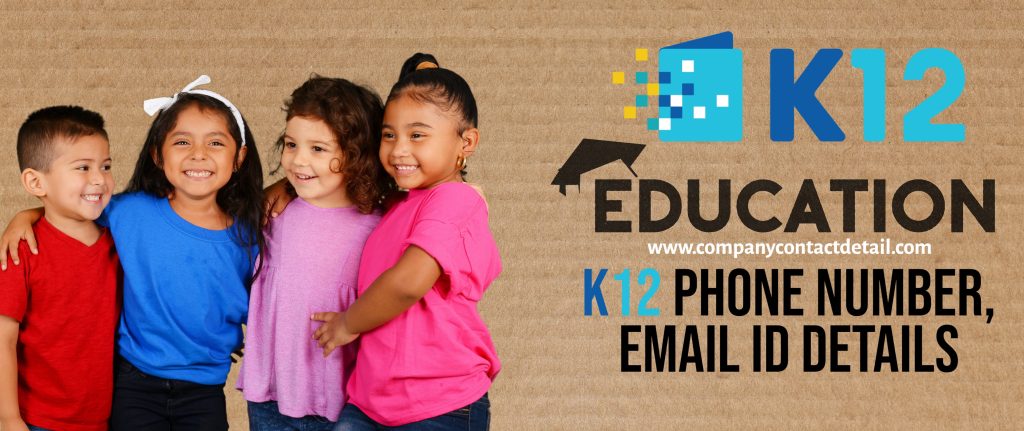K12 Phone Number: In both the US and Canada, primary and secondary education is provided by the government for several years. This grade level is sometimes referred to as kindergarten–twelfth grade, or K–12. It is comparable to the amount of time needed to finish public school grades in several other countries, including Afghanistan, Australia, Canada, China, Ecuador, India, Iran, the Philippines, South Korea, and Turkey, before pursuing tertiary education. K–12 refers to the American educational system that grants local sectoral “districts” control. These districts may be exclusive to a town, county, or many areas, contingent upon population density and proximity.
| Name | K12 |
| Founded In | 2000 |
| Phone Number | (866) 283-0300 |
| Email Address | login now to view the detail |
| Twitter ID | login now to view the detail |
| Instagram ID | login now to view the detail |
| Facebook ID | login now to view the detail |
| LinkedIn Profile | login now to view the detail |
| Official Website | Click Here to Visit |

Also Read: Pierson Wodzynski Phone Number, Digitize India, Digitize India Platform, Work From Home Jobs, Celebrity Phone Number, Digital India, Scholarship
Contents
History
2005
The initial chairman of the board of the corporation was William Bennett. The Secretary of Education under Ronald Reagan, who held the position until 2005.
2013
In return for minority ownership, several K12 companies, notably Capital Education and the International School of Berne. Whose combined sales in 2013 were $20.3 million, will relocate to the new enterprise.
2014 To launch Pansophic Learning, founder Packard resigned in 2014.
2020 On December 16, 2020, K12 Inc. changed its corporate name to Stride, Inc.
2021
Stride Inc. (previously K12 Inc.) announced on January 27, 2021, that James J. Rhyu will succeed Nate Davis as CEO. Davis would be retiring. Davis will continue to serve as the board’s executive chairman.
Pros and cons
Pros
- Prepared for college: By segmenting the learning process into digestible parts. The K–12 curriculum aims to assist students in becoming ready for college.
- Work readiness: Grade-level instruction is crucial since each level is broken down into smaller parts to provide students with sufficient preparation materials for the workforce. The goal of the course curriculum is to equip students for a variety of real-world work situations.
- Kids’ abilities are enhanced since K–12 is structured such that every level has adequate material. The knowledge they need to make decisions that will impact their lives on their own.
- The twelve years spent in elementary and secondary school split education into parts. If the system hadn’t been divided into more manageable, smaller parts, it would have been far too complex.
- It facilitates simple understanding: By segmenting the educational system into distinct learning phases. As they progress through the educational system, kids might only be able to comprehend the ideas being taught.
- The K–12 curriculum is divided into many levels to suit kids with similar interests. All children gain from the supportive learning environment it generates.
Cons
- Ready for college: The K–12 curriculum attempts to help kids become ready for college by breaking down the learning process into manageable chunks.
- It takes a while: to enrol in postsecondary education, students must complete thirteen years of classroom instruction under the K–12 education paradigm. This is lengthy and tedious, especially for developing youngsters.
- It is exhausting: students enrolled in this type of education must spend up to eight hours a day in class for thirteen years. This is tedious in addition to being long.
- It lessens students’ desire to learn: As with any lengthy process, children are likely to lose interest in learning by the time they reach the midway point in this type of education.
- It is expensive for parents: The K–12 educational system is expensive, particularly because it is long and necessitates pupils to attend school for several years.
- It is expensive for parents: The K–12 educational system is expensive, particularly because it is long and necessitates pupils to attend school for several years.
- Some schools using this educational method do not have enough facilities because of the heavy pressure the system places on the already few resources.
- Exclusively advantageous to private schools: The system exclusively serves profit-driven private schools, which come at the expense of public schools.
Execution
k12 phone number: Public and private educational establishments in India frequently employ the K–12 system to teach all pupils. The government has mandated free and universal elementary education. Currently, there are 1.46 million K–12 schools in the country, with the federal, state, or local governments running 54% of them, municipal corporations or local authorities running 21%, and the private sector running 25%. All boards, including the CISCE, CBSE, State Boards, IB, and other international boards like the CIE and IGCSE, are connected to the K–12 system.

Also Read: Drew Carey Phone Number
Objective
The K–12 model aims to systematise the allocation of education for students entering school at all age levels before their college attendance. Different forms of segmentation, such as ownership, board, or level-based, are used to cater to the requirements of individual pupils. K12 strives to make education more focused on requirements that are pertinent to customising it.
Advantages
k12 phone number: Based on the cognitive abilities of their pupils, teachers can tailor their education. The curriculum is created with academic and extracurricular activities in mind, taking into account the pupils’ level of mental development and physical health.
The K–12 system places a strong emphasis on level-appropriate teacher preparation. guarantees students’ ongoing academic and non-academic growth. Prioritise developing in-depth knowledge and a passion for the subjects you study. Discover and nurture each learner’s unique potential. Develop your capacity to connect with others and your social abilities.
FAQs on k12 Phone Number
Q. What are the main advantages of the K–12 system of education?
Ans. The K–12 educational system has many important advantages, such as giving students a solid foundation in important subjects and abilities, ensuring that everyone has access to a top-notch education, assisting them in mastering social skills, fostering technological proficiency, and preparing them for the competitive global job market.
Q. How does the K-12 educational system lay a strong foundation?
Ans. The K–12 educational system helps students’ foundations in math, science, language, and social sciences. It aids with the mastery of fundamental abilities including writing, reading, and independent study.
Q. Why is access to a top-notch education made possible by the K–12 system?
Ans. Education is now more accessible to children who face logistical, socioeconomic, or health-related challenges because of advancements in K–12 education. The system guarantees that students across the United States have access to high-quality education, and the expansion of virtual learning environments adds to this accessibility.
Q. In what ways does the K–12 educational system aid in students’ social skill mastery?
Ans. The K–12 education that students get has a big impact on their social development. Interactions with instructors and peers help students enhance their networking, collaboration, and communication skills.
Suggested Link: Typing speed, Aadhar Card, Digital India
@ROT
